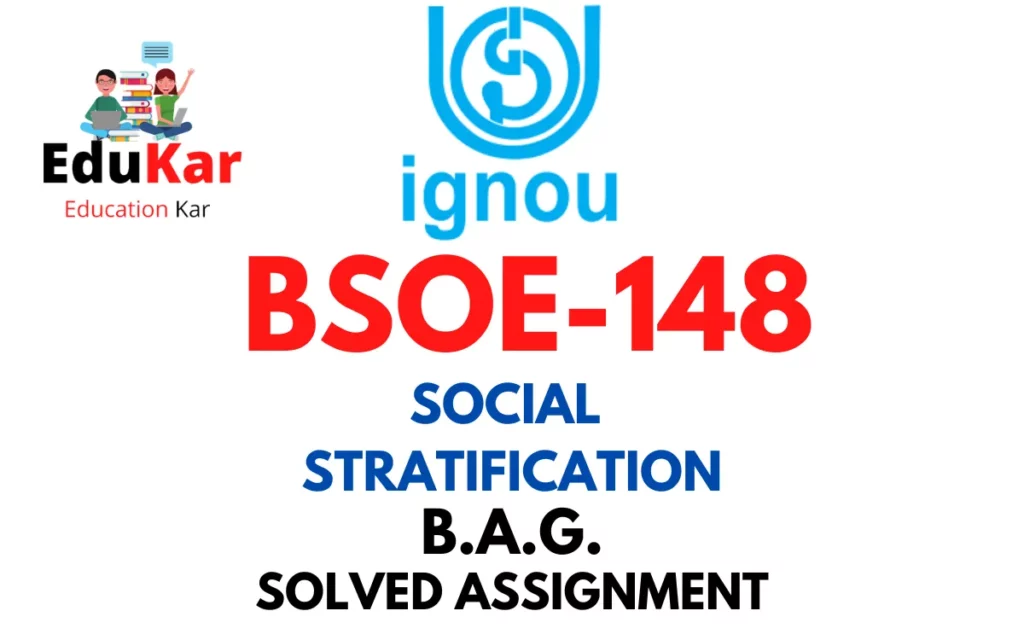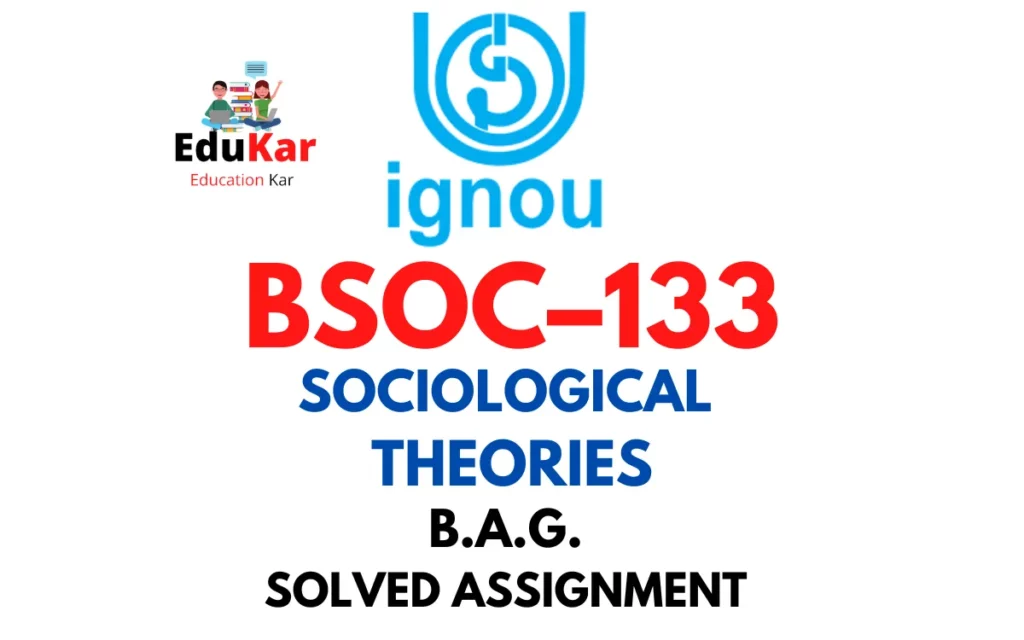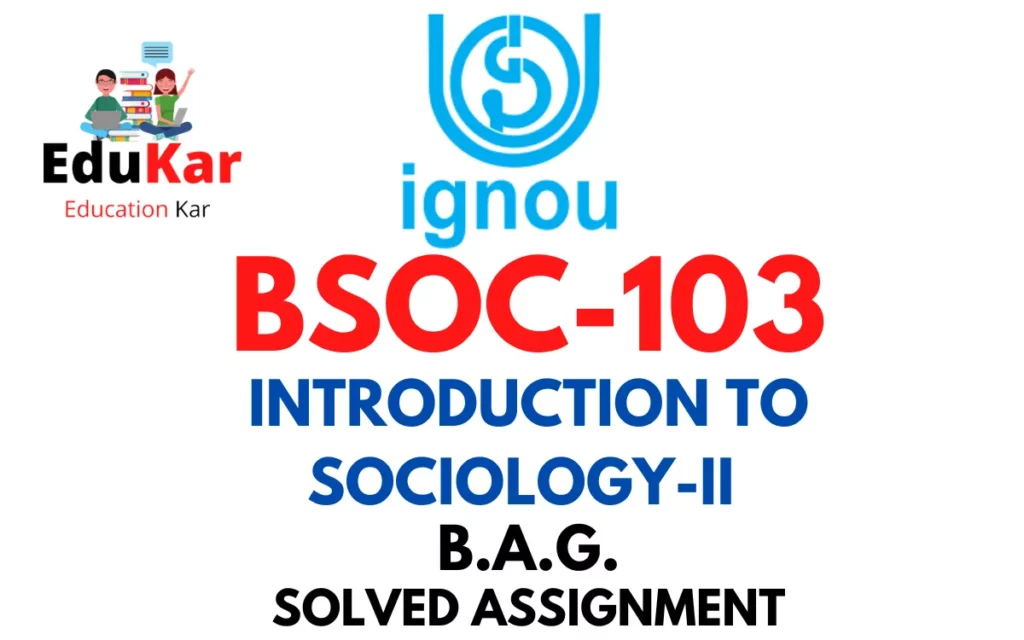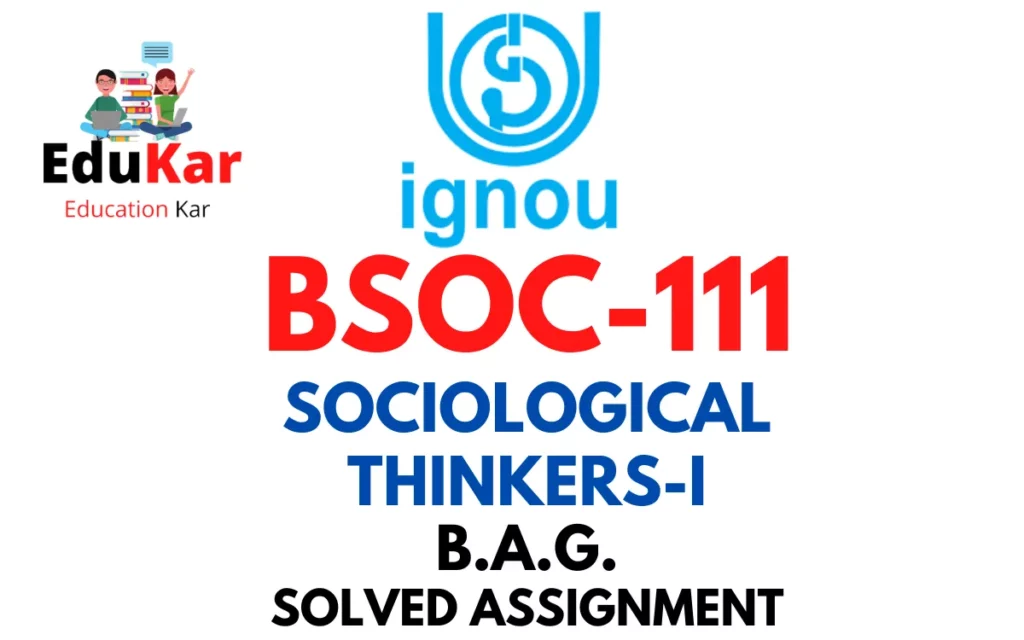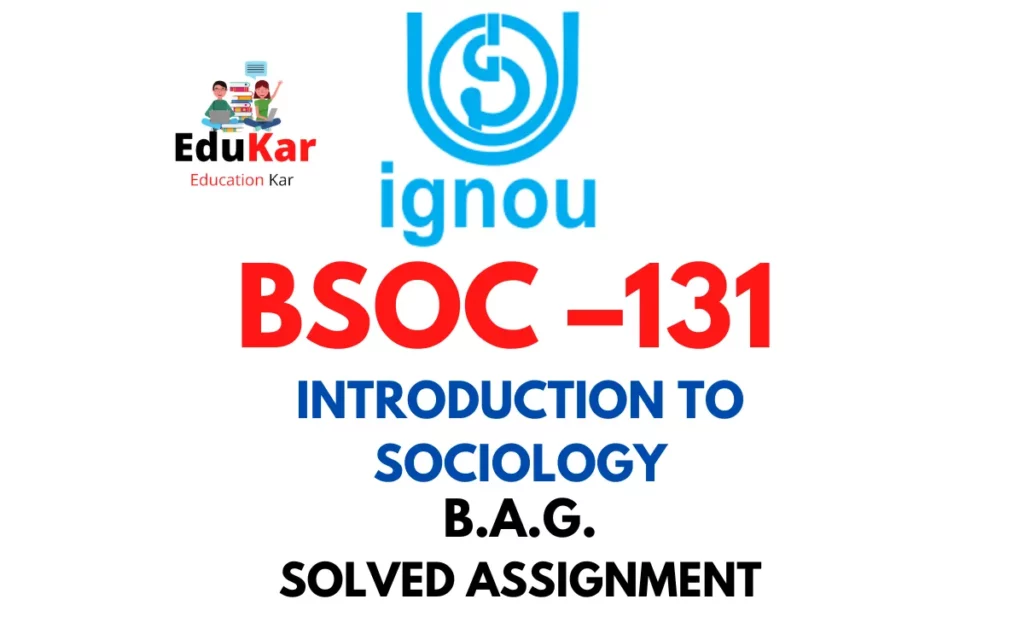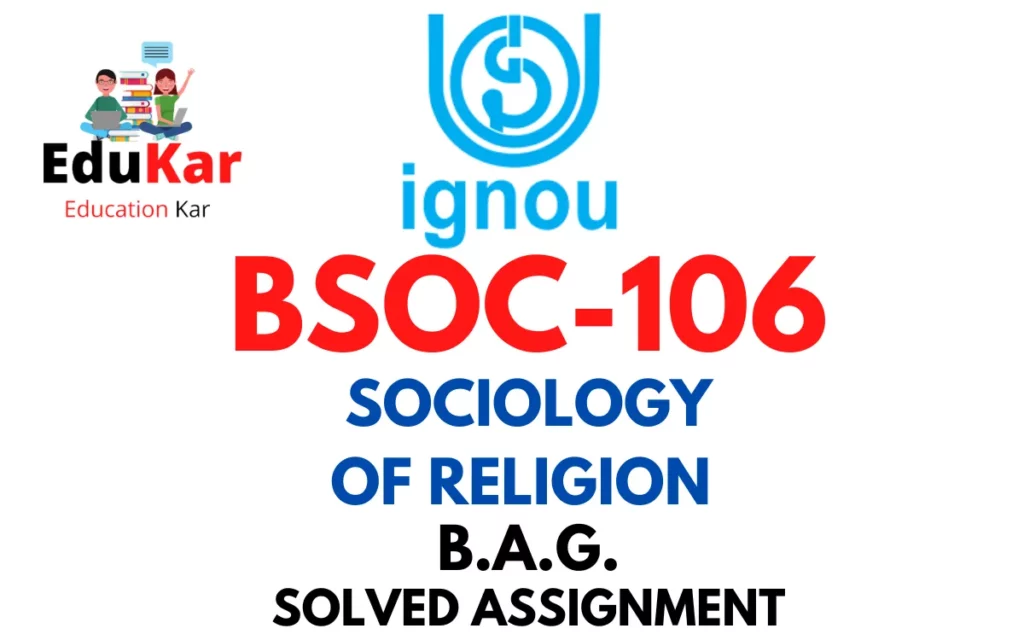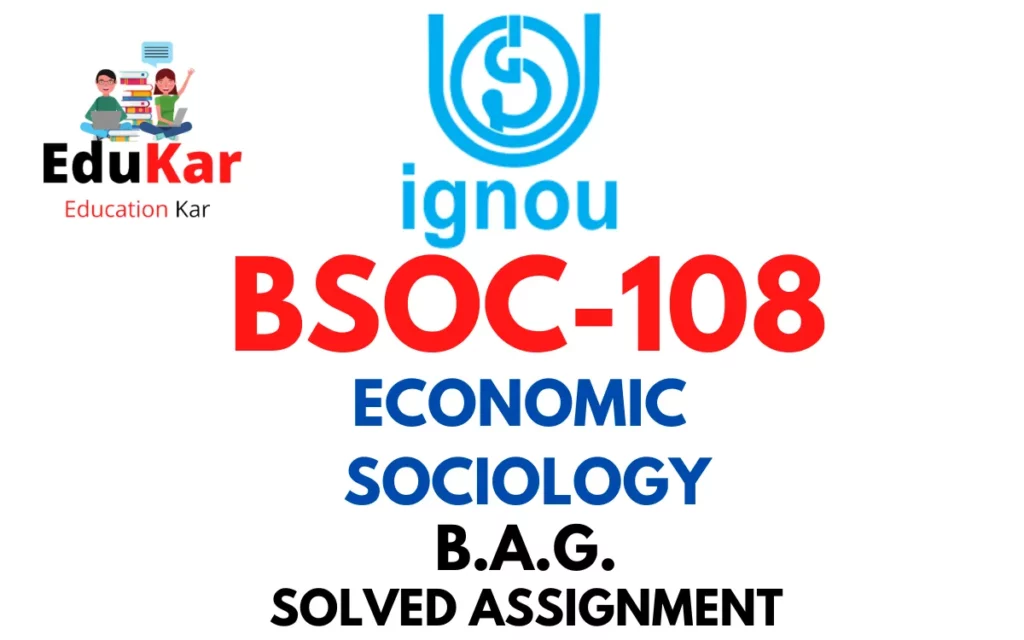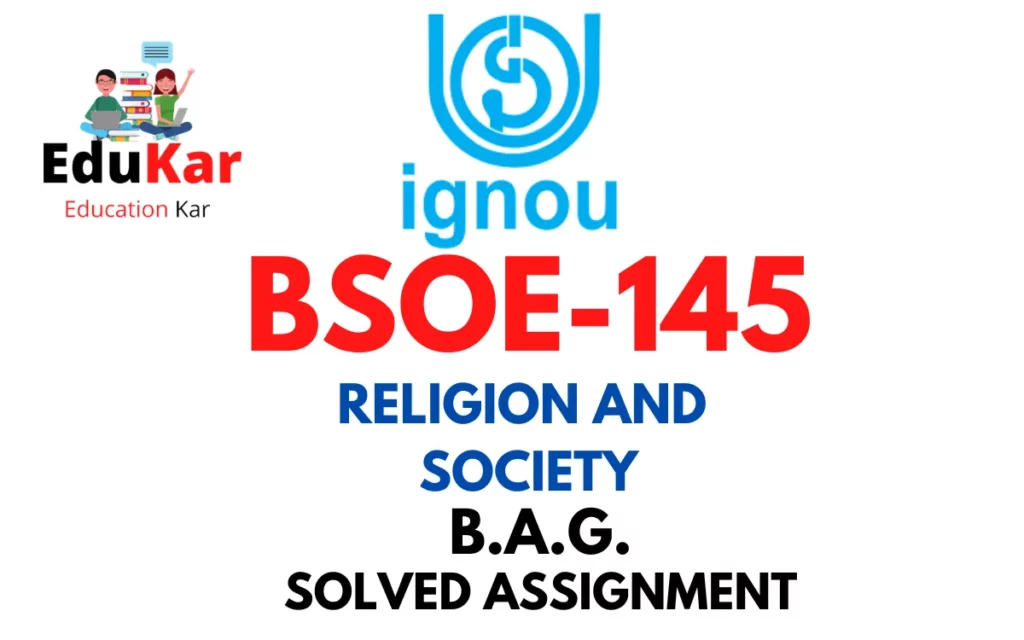Contents
- 1 Assignment – I
- 2 Answer the following in about 500 words each.
- 3 1. Explain the Weberian theory of social stratification.
- 4 2. Discuss the bases of social stratification.
- 5 Assignment – II
- 6 Answer the following in about 250 words each.
- 7 3. Explain class as a form of stratification.
- 8 4. Discuss the political perspective on ethnicity.
- 9 5. How socialization affects gender identities? Discuss.
- 10 Assignment – III
- 11 Write a note on the following in about 100 words each.
- 12 6. Racism.
- 13 7. Intergenerational mobility.
- 14 8. Features of caste.
- 15 9. Ethno-nationalism.
- 16 10. Estate system.
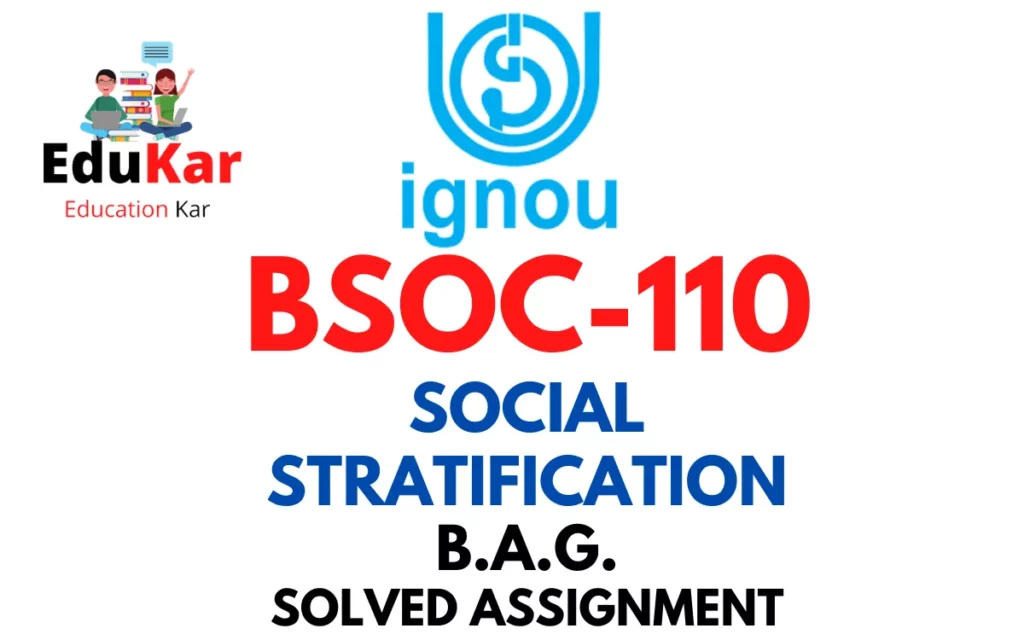
| Title | BSOC-110: IGNOU BAG Solved Assignment 2022-2023 |
| University | IGNOU |
| Degree | Bachelor Degree Programme |
| Course Code | BSOC-110 |
| Course Name | SOCIAL STRATIFICATION |
| Programme Name | Bachelor of Arts (General) |
| Programme Code | BAG |
| Total Marks | 100 |
| Year | 2022-2023 |
| Language | English |
| Assignment Code | ASST/TMA/ 2022-23 |
| Assignment PDF | Click Here |
| Last Date for Submission of Assignment: | For June Examination: 31st April For December Examination: 30th September |
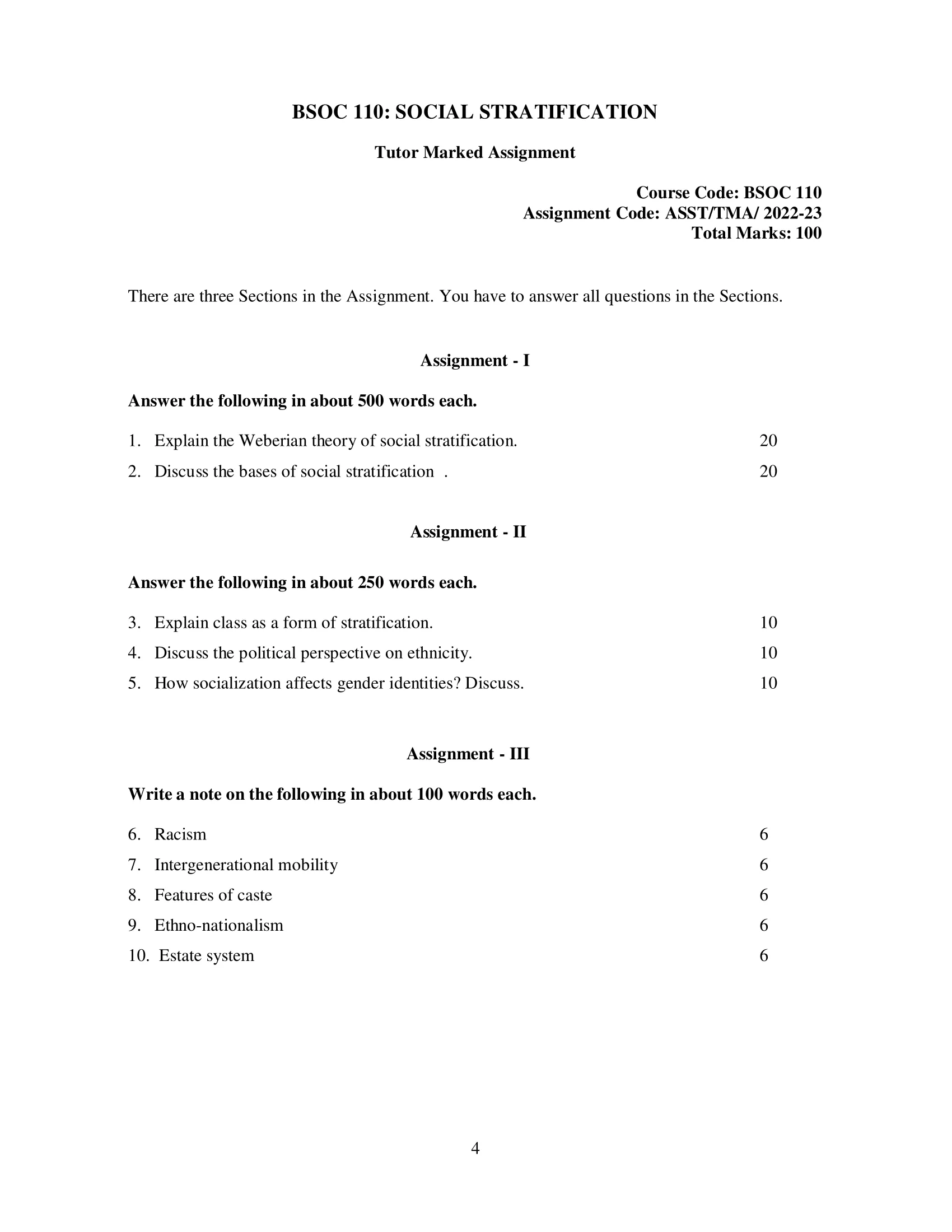
Assignment – I
Answer the following in about 500 words each.
Ans: The Weberian theory of social stratification was developed by the German sociologist Max Weber in the early 20th century. According to Weber, social stratification is a system of inequality that is based on the unequal distribution of power, prestige, and wealth among members of society. In other words, it is a system that places people into different classes based on their level of status, income, and access to resources.
Weber identified three main dimensions of social stratification: class, status, and party. Class refers to a person’s economic position in society and is determined by their income, wealth, and occupation. Status refers to a person’s social position or prestige and is determined by their education, occupation, and lifestyle. Party refers to a person’s political power and is determined by their ability to influence government decisions and policies.
Weber argued that social stratification is not solely based on economic factors, as many Marxists believe, but also on social and political factors. For example, a person’s level of education, occupation, and lifestyle can also determine their level of status and influence in society. Additionally, Weber believed that social stratification is not a fixed system, but rather a dynamic one that can change over time.
One of the key concepts in Weber’s theory of social stratification is social closure. Social closure refers to the process by which certain groups try to maintain their position in society by excluding others from access to resources and opportunities. This can be done through a variety of means, such as restricting access to education or jobs, or creating exclusive social networks.
Weber also introduced the concept of life chances, which refers to the opportunities that a person has in life based on their social position. For example, a person born into a wealthy family has a greater chance of success in life than someone born into a poor family. This concept highlights the idea that social stratification can have a significant impact on a person’s life and opportunities.
Ans: Social stratification is a system of inequality that divides people into different social groups based on their perceived worth or value in society. This division is based on a range of criteria or bases of social stratification, including:
- Wealth and Income: This refers to the amount of money a person has, either in the form of assets (such as property, investments, or savings) or income (such as wages or salaries). Wealth and income are key determinants of a person’s economic status, and people with higher wealth and income tend to occupy higher positions in the social hierarchy.
- Education: Education is a significant factor in social stratification, as it can determine the type of job a person can get, their income, and their social status. People with higher levels of education tend to have more access to high-paying jobs, which in turn can give them a higher social status.
- Occupation: Occupation is closely linked to education, as people with higher levels of education tend to have access to higher-paying and higher-status occupations. However, the type of occupation a person has can also be influenced by factors such as race, gender, and social background.
- Power and Authority: Power and authority refer to the ability to control resources and make decisions that affect others. In many societies, political power and authority are concentrated in the hands of a small group of people, such as a ruling class or a political elite. This concentration of power can be a significant basis for social stratification.
- Social Networks: Social networks refer to the relationships and connections that a person has with others in society. These networks can provide access to resources, information, and opportunities, and can be an important factor in determining a person’s social status.
- Gender: Gender is a significant basis for social stratification in many societies, with men often occupying higher social positions than women. This is due to a range of factors, including gender-based discrimination in education, employment, and political representation.
- Race and Ethnicity: Race and ethnicity are also key bases of social stratification in many societies, with people of certain races and ethnicities often experiencing discrimination and disadvantage in areas such as education, employment, and political representation.
These bases of social stratification are often interrelated and can interact in complex ways. For example, a person’s occupation may be influenced by their level of education, which in turn may be influenced by their family’s wealth and social networks. Additionally, social stratification can be reinforced and perpetuated through various forms of discrimination, such as discrimination based on race or gender, which can limit people’s opportunities and social mobility. Understanding the bases of social stratification is important in identifying and addressing social inequality in modern societies.
Assignment – II
Answer the following in about 250 words each.
3. Explain class as a form of stratification.
Ans: In sociology, class is a form of stratification that refers to the hierarchical organization of individuals into different groups based on their economic and social status. Social class is often determined by an individual’s income, occupation, education, and social standing.
Social class is a form of stratification because it creates a system of social hierarchy where people are divided into different groups based on their wealth, status, and power. In capitalist societies, the bourgeoisie (owners of the means of production) are at the top of the social class hierarchy, followed by the middle class (white-collar workers, professionals, and business owners), and the working class (blue-collar workers and those in service jobs). Social mobility is the ability of an individual to move up or down the social class ladder, although this may be difficult due to the structural inequalities inherent in the system.
Social class has a significant impact on an individual’s life chances, as it affects access to education, job opportunities, and social networks. It also shapes an individual’s lifestyle, values, and cultural practices, and influences their consumption patterns and preferences.
The concept of class is often associated with Marxist theory, which argues that class conflict is a driving force behind social change. Marx believed that the working class, who are exploited by the bourgeoisie, will eventually overthrow the capitalist system and establish a classless society.
4. Discuss the political perspective on ethnicity.
Ans: The political perspective on ethnicity refers to the ways in which ethnic identities are constructed, mobilized, and utilized for political purposes. Ethnicity is a socially constructed identity that is based on cultural, linguistic, or ancestral ties, and political actors often use these ties to gain power, resources, and representation. Ethnic politics can manifest in various forms, such as ethnic nationalism, ethnic conflict, and ethnic voting blocs.
One perspective on ethnicity in politics is the primordialist view, which suggests that ethnicity is a deeply rooted, natural, and innate aspect of human identity. This view argues that people are naturally drawn to others who share similar cultural, linguistic, or ancestral ties, and that ethnic conflicts arise when these ties are threatened. Primordialists believe that ethnicity is a fixed and unchanging aspect of identity, and that it overrides other social identities, such as class or religion.
On the other hand, the instrumentalist view of ethnicity suggests that ethnic identity is not an inherent characteristic, but rather a strategic tool that is used to advance political interests. This perspective argues that political actors can create or manipulate ethnic identities in order to mobilize support, gain power, or secure resources. Instrumentalists argue that ethnic identities are fluid and malleable, and can be changed or discarded when they no longer serve a political purpose.
Another perspective on ethnicity in politics is the constructivist view, which suggests that ethnic identities are socially constructed through interaction and communication. This perspective argues that ethnic identities are not fixed or innate, but are shaped by historical, political, and cultural factors. Constructivists believe that ethnicity is a dynamic and evolving aspect of identity, and that it can change over time as a result of social and political processes.
Ans: Socialization is the process by which individuals learn and internalize the norms, values, and beliefs of their society or culture. Gender identity is a person’s subjective sense of being male, female, or somewhere in between, and is shaped by socialization processes. Socialization affects gender identity in several ways, including through gender roles, gender stereotypes, and gender socialization practices.
Gender roles refer to the social expectations that are associated with being male or female. These roles are learned through socialization and can differ across cultures and time periods. For example, in some societies, men are expected to be the primary breadwinners, while women are expected to take care of the home and children. These roles can influence the development of gender identities, as individuals learn to conform to these expectations and internalize them as part of their gender identity.
Gender stereotypes are oversimplified and rigid beliefs about the characteristics and behavior of men and women. These stereotypes can be reinforced through socialization, such as in children’s books, media, and toys. For example, girls are often given dolls and dress-up clothes, while boys are given toy trucks and action figures. These stereotypes can limit the range of gender identities that are seen as acceptable, and can lead to the development of rigid and narrow gender identities.
Gender socialization practices refer to the specific ways in which individuals are taught to be masculine or feminine. This can include the ways in which parents interact with their children, the messages that children receive from peers and teachers, and the ways in which media portrays gender. For example, boys may be encouraged to engage in rough-and-tumble play, while girls may be encouraged to play quietly and engage in nurturing activities. These socialization practices can influence the development of gender identities and can reinforce gender roles and stereotypes.
Assignment – III
Write a note on the following in about 100 words each.
6. Racism.
Ans: Racism is a belief system that considers certain races or ethnicities to be inherently superior or inferior to others. This belief is often accompanied by discriminatory practices that limit the opportunities and access to resources of people of certain races or ethnicities. Racism can take many forms, including individual acts of prejudice and discrimination, as well as systemic or institutionalized racism that is built into social, economic, and political structures. Racism has significant negative impacts on individuals and society, perpetuating inequality and limiting social mobility. It is important to address and combat racism through education, advocacy, and policy changes.
7. Intergenerational mobility.
Ans: Intergenerational mobility refers to the extent to which a person’s social and economic status is influenced by their family background. In other words, it measures the extent to which children’s social and economic outcomes are similar or different from those of their parents. Intergenerational mobility can be upward, downward, or remain stable, and it is influenced by a range of factors, such as family income, education, social networks, and access to resources. High levels of intergenerational mobility are seen as a measure of a fair and equal society, while low levels of mobility can perpetuate inequality and limit social and economic opportunities for future generations. Policymakers often use intergenerational mobility data to inform social and economic policies aimed at increasing equality and social mobility.
8. Features of caste.
Ans: Caste is a system of social stratification that has existed in India for thousands of years. It is based on the division of people into hereditary social groups or castes, each of which has its own distinct status, role, and occupation. The following are some of the key features of the caste system:
- Hereditary: Caste is a hereditary system, which means that a person’s caste is determined by the caste of their parents. This means that a person’s social status and occupation are often predetermined from birth.
- Endogamous: Caste is an endogamous system, which means that people are expected to marry within their own caste. This reinforces the social and cultural boundaries between castes.
- Occupational: Caste is an occupational system, meaning that each caste is traditionally associated with a particular occupation or profession. For example, the Brahmin caste is associated with religious and intellectual pursuits, while the Kshatriya caste is associated with military and administrative roles.
- Hierarchy: Caste is a hierarchical system, with some castes being considered higher or more prestigious than others. This hierarchy is often based on factors such as purity, education, and wealth.
- Discriminatory: The caste system is a discriminatory system, with people from lower castes often facing discrimination and exclusion in various aspects of social, economic, and political life. This can include restricted access to education, healthcare, and other basic services, as well as limited opportunities for social and economic mobility.
- Perpetuation: Caste is a self-perpetuating system, meaning that the social and economic advantages or disadvantages of one’s caste tend to be passed down from generation to generation. This can make it difficult for people from lower castes to break out of the cycle of poverty and exclusion.
- Regional Differences: Caste practices can vary regionally, with different castes being dominant in different regions. Additionally, the system of caste can be influenced by other factors, such as religion, language, and cultural practices.
9. Ethno-nationalism.
Ans: Ethno-nationalism is a political ideology that is based on the belief that a nation should be defined by a shared ethnic identity, culture, or ancestry. This ideology holds that individuals within a nation should share a common language, history, and culture, and that the nation should be defined in terms of these characteristics. Ethno-nationalists often argue that the state should prioritize the interests of the dominant ethnic group, and may advocate for policies such as ethnic homogeneity, cultural preservation, or even ethnic separation or exclusion.
Ethno-nationalism has been associated with various forms of political action, ranging from peaceful activism to violent conflict. Some ethno-nationalist movements have sought to achieve greater autonomy or independence for their communities within the context of an existing state, while others have sought to establish entirely separate and independent nation-states. In some cases, ethno-nationalist movements have been associated with discrimination, prejudice, or even violence against minority groups within the state or region.
Critics of ethno-nationalism argue that it can be divisive and exclusionary, and can lead to conflict and discrimination against minority groups. They argue that defining a nation in terms of ethnic identity can be arbitrary and exclusionary, and may neglect the contributions and perspectives of individuals from diverse backgrounds. Additionally, they argue that prioritizing the interests of one ethnic group over others can lead to social and political inequality, and may undermine the principles of democracy and human rights.
10. Estate system.
Ans: The estate system was a form of stratification that existed in medieval Europe, in which society was divided into three estates: the clergy, the nobility, and the commoners. The clergy were responsible for religious and spiritual matters, the nobility were responsible for military and administrative affairs, and the commoners were responsible for manual labor and commerce. Each estate had different rights and privileges, and social mobility was limited. This system was based on the belief that each estate had a specific role to play in society, and that maintaining the social order was essential for the well-being of all. The estate system began to decline during the Enlightenment period, as ideas about individual rights and social equality gained prominence.
How to Download BSOC-110 Solved Assignment?
You can download it from the www.edukar.in, they have a big database for all the IGNOU solved assignments.
Is the BSOC-110 Solved Assignment Free?
Yes this is absolutely free to download the solved assignment from www.edukar.in
What is the last submission date for BSOC-110 Solved Assignment?
For June Examination: 31st April, For December Examination: 30th October

